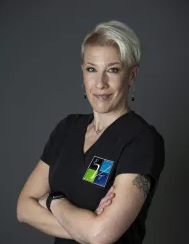Home / VetSnap Sponsored CE Webinar, Intro to Anesthesia Fundamentals – Summary and Takeaways
EVT and VetSnap, Saving Time and Mindshare for Self Care and Patient Care
Breaking a Challenge into its Pieces
Controlled death. This statement strikes fear into many a veterinary technician’s heart, mine included when I first got into this field. As I learned more about the science behind it, and then was able to apply it on live cases, I grew to LOVE it. If nothing else it was the word ‘control’ that spoke to me. I literally possessed the knowledge and skills to hold this precious animal’s life in my hands. Terrifying? Certainly. Exciting? Definitely. Let’s talk…
Anesthesia when broken down is quite simply the lack or absence of sensation. It becomes that much more impactful when combined with analgesia – the absence of pain. Those of us that love a deeper dive and truly geek out over these disciplines like to take it a step further into multi-modal anesthesia – sedatives, hypnotics, analgesics – by their powers combined! And truly when we break any anesthetic case down to its parts – preparation, induction, maintenance, and recovery – it becomes that much easier to digest, understand & enact.

Nervously Excited
Now this doesn’t mean anyone’s nerves ever fully & truly go away, and truth be told, they shouldn’t. Being nervous doesn’t mean you’re incapable, it means you CARE. In our profession, this is critical and a necessary part of any and every task that we undertake for our patients. However, when you possess the knowledge and skill to undertake an anesthetic case it’s definitely something worth noting and when it’s completed accurately & well – celebrating!
Think of it this way; you’ve got a puppy coming in for their six-month wellness visit. This is the time we talk about finalizing their vaccination protocol – if it hasn’t been completed already by their 4 month/16-week check-up – and pending the puppy’s breed (yes, I firmly agree that large/giant breed dogs should wait until one-year of age for sterilization, but that’s a whole other post!), this is when the discussion about spay/neuter takes place as well. When you’re having this conversation you cover EVERYTHING with the puppy’s owner correct? And when you’re examining the puppy, you are very thorough – starting at the nose and addressing every part & organ system through to the tail – correct? Approach any & every anesthetic case the same way; systematically, step-by-step, don’t overthink it, and you’ll then master your nerves instead of them mastering you.
Yes, I am aware this is a very oversimplified statement, but really when we get down to it, isn’t that the goal? Working smarter not harder makes sense for so many reasons, and anesthesia is no different. What IS different is in the approach to learning this intricate & challenging discipline and that’s what we’re going to talk about next.
Make a List, Then Check it Twice
When you’re heading into the OR – any OR I don’t care if it’s GP or ER/Specialty – having SOPs in place that we don’t deviate from is the 1st place to start. Checklists for every job or role within the team, even if they overlap or repeat – in a surgical setting, there is very little room (if any) for error. When you have these protocols & visual reminders in place, is when it’s time to get your team up and running, and in some cases this is literally the case!
You’ll need your assistants trained up as restrainers & patient preppers as well as surgical suite runners (go-to gofers) & scrubbing in with the surgeons. Now, depending upon your practice you may have your VTs as your scrub nurses, that is entirely up to you – just make sure that whoever is handing instruments to the surgeon & getting their hands into a pair of sterile gloves knows EXACTLY what, where, when & how they’re supposed to do their job.
Your veterinary technicians are your anesthetists and wow, when these people are fully versed in pharmacology, A&P, anesthesiology & overall badassery, you are SET. Having a credentialed (CVT/LVT/RVT) at the helm is what we’d recommend as having not only the hands-on training, but the educational background is critical to a thorough understanding of the processes at hand. From initial pre-anesthetic PE to induction, ensuring that hearts are beating & lungs inflating throughout, and at times literally carrying their patients through the recovery process, this takes a LOT of know-how. Whenever a new team member joins your practice, make sure that there is a comprehensive, competency-based anesthesia training program in place that involves practice cases with working mannequins, medical math & ER skills evaluations. Trust me, the time and effort put into this is well worth it.
Woven throughout these team members and their skills training should be a thread of communication & commitment to managing their stress. Too often these skills are lumped into the misnomer of ‘soft’ when there’s nothing fluffy about relaying to your VT that they’re going to be doing back-to-back thoracotomies and then staying late for an unstable GDV!
